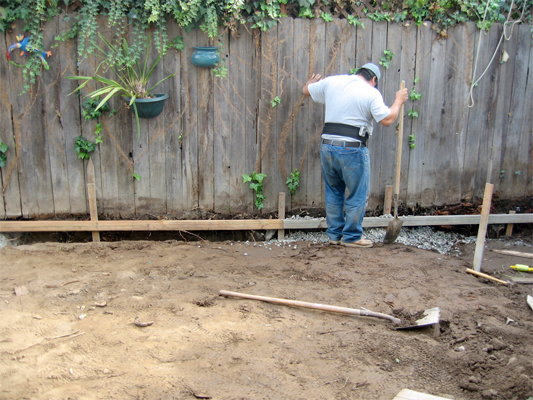
Even if you rent a trenching tool, there’s still going to be a lot of digging involved in a French drain system installation. Image: EOShea/Flickr
Digging Your Own French Drain: Save Money — and Your Back — With These Tips
Published: June 16, 2011
Do you need to wear waders to mow your grass? If seasonal flooding makes your property more lake than lawn, which isn’t doing your foundation any favors, you need some serious drainage. Good news: You can do it yourself — if you’re up for the digging.
Where I live, in the Pacific Northwest, the last few springs have been some of the soggiest on record — and in the Northwest, that’s really saying something. Around April, my side yard turns into my own private Everglades, complete with frogs.
Finally, I decided to do something about it. Enlisting the help of a friend (I owe him big-time) and my son, Nick, (strong backs are required), I set out to dig a French drain, and along the way save some bucks by doing it myself.
A French drain is simply a plastic drain line embedded in a gravel-filled ditch. Surplus ground water enters the pipe, and gravity whisks it away, either to a drier spot in your yard, to a storm drain system, or out into the street.
Sound simple? It is — except for the digging. Here’s what I learned about putting in a 50-foot-long French drain:
- Tell everyone it’ll take three days. You’ll probably finish in two, which sort of makes up for the back-breaking work.
- Schedule the job for when the ground is moist but not saturated. Wet dirt clogs everything up; really dry dirt is tough to dig.
- Dig smart and safe. Call 811, the “dig safely” hotline, to mark underground utilities before you start.
- Rent a trenching tool (about $125 to $200 per day). This gas-powered digger resembles a big rototiller, and it’ll do a lot of the digging for you. But heads up: It’s heavy, and you’ll need three people just to wrestle it on and off a truck. Ask if your rental company delivers and picks up.
- Lay big pieces of scrap plywood next to your ditch line, and let the trenching tool throw the excavated dirt onto the plywood. This makes it about one thousand times easier to deal with the dirt afterward. You’re going to have to put it somewhere because you’ll fill in the trench with gravel. A raised flower bed is great.
- Note that even with the trenching tool, you’ll still have to shovel a lot of dirt and gravel. A couple of shovels and two wheelbarrows make the work go a lot faster.
All in all, this was one of the most labor-intensive jobs I’ve done. Was it worth it? I figure I saved about $1,000 over the cost of a pro, minus those two beers I served my buddy.
Would you dig your own French drain? What’s the toughest DIY home improvement you’ve done?
Read more: http://members.houselogic.com/articles/digging-your-own-french-drain-save-money-and-your-back-these-tips/preview/#ixzz32NuwWGqK
Follow us: @HouseLogic on Twitter | HouseLogic on Facebook
 Facebook
Facebook
 X
X
 Pinterest
Pinterest
 Copy Link
Copy Link

